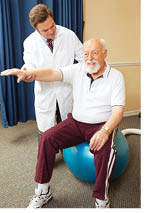:dropcap_open:R:dropcap_close:ange of motion and muscle testing are critical to developing treatment plans, and insurance reimbursement depends on providing accurate reports that demonstrate need for care and document improvement objectively; however, this necessity is time-consuming to perform if done manually.
 But today you no longer have to go the manual route, with relatively inexpensive automated systems where the entire process can be reduced – both testing AND reporting – to an average of mere minutes.
But today you no longer have to go the manual route, with relatively inexpensive automated systems where the entire process can be reduced – both testing AND reporting – to an average of mere minutes.Range of Motion and Muscle Testing – coupled with a suite of easy-to-use, integrated software modules – can be used for accurate measurement and serve as instant documentation. Oftentimes, the devices and their associated modules can be purchased separately or as a package.
A computerized testing system not only creates instant reports to submit for insurance reimbursement, it also creates reports needed to get the patient approved for more visits if necessary, with clear documentation that is easy to understand and implement.
The reports can compare the patient’s range of motion with the published AMA guidelines, clearly itemizing improvement and limitation on any test date during the treatment period. For documenting muscle weakness, for instance, the reports can compare the patient’s left and right sides for each muscle (asymmetric muscle strength, if applicable). A system may print out the patient’s limitation at any time during the treatment period, thus clearly being able to document limitation or impairment and demonstrate improvement over time.
Defining “Medical Necessity”
According to healthinsurance.com, medical necessity is defined as follows:
“Health insurance companies provide coverage only for health-related services that they define or determine to be medically necessary.”
Medicare, for example, defines medically necessary as: “Services or supplies that are needed for the diagnosis or treatment of your medical condition and meet accepted standards of medical practice.”
Medical necessity refers to a decision by your health plan that your treatment, test, or procedure is necessary for your health or to treat a diagnosed medical problem. Chiropractors must now provide proof of medical necessity or risk not only declined reimbursement, but also risk having an insurance company seek to be paid back claims they have already paid to the doctor. It is not uncommon for insurance companies to request to be paid back $50,000 or $100,000. For most chiropractors, having to pay back thousands of dollars of their hard-earned money would not result in a good day. With a computerized testing and documentation system, a doctor can virtually eliminate this concern and sleep better at night.
Single vs. double inclinometers: What’s the difference?
:dropcap_open:Chiropractors must now provide proof of medical necessity or risk not only declined reimbursement, but also risk having an insurance company seek to be paid back claims they have already paid to the doctor.:quoteleft_close:
The basic idea of inclinometry is to measure the difference between two angles or the difference between a neutral position for a specific range of motion and an ending position.
A single inclinometer is a “singular” measuring device. It reads one angle measurement or the difference between two positions of the inclinometer, the neutral or starting position and the ending position. The chiropractor would then subtract the second measurement from the first to obtain the range of motion. For digital single inclinometers that are part of a testing and documentation system the work of documenting and calculating angles and measurements is automatically taken care of.
“Dual” inclinometers are two devices that can read two angles at the same time. When taking a spinal range of motion reading, the primary inclinometer is centered in the starting position, and the secondary in the ending position. As the patient is going through the range of motion, the doctor would lock in the starting position and, after movement, the ending position of the range of motion. For lumbar flexion, for example, the chiropractor will place one of the inclinometers on T12 and the other inclinometer on S1. Then the sacral measurement is subtracted from the T12 measurement to obtain true lumbar flexion. If the dual inclinometers are communicating with software, the program would typically automate the calculation of the angle, calculate improvement between visits and quantify any limitations in accordance with published guidelines.The software is capable of creating instant documentation for insurance, patient, and doctor.
Digital dual inclinometers can also function as a single inclinometer (just disconnect the secondary from the primary). For diagnosing and assessing back problems, spinal range of motion measurements are simpler and more accurately taken with dual inclinometers. To ensure that the patient is giving maximum effort the reproducibility criteria is followed. Having dual inclinometers and a software system takes out the headache of repeatability, calculating validity manually, and just the pure frustration that comes with keeping track of all the numbers consistently. The doctor could take two single inclinometer readings and then subtract one from the other manually, but one may consider that method inefficient and prone to error. However, dual inclinometers do cost a little more; it is up to the doctor to assess if it is worth the extra cost. “But, as they say, time is money.”
Daniela Birkelbach is the founder and owner of Kennebec, Inc., makers of the Proof Preferred system. You can reach her at 412 278-2040 or email any questions to [email protected] or visit www.proofpreferred.com
